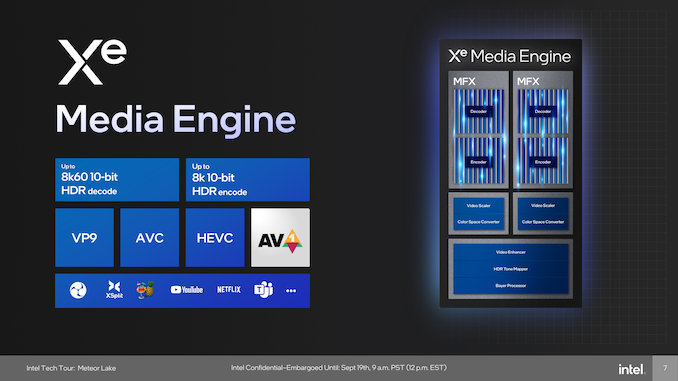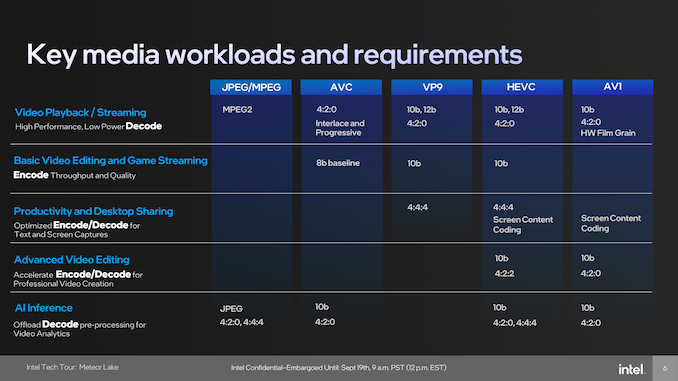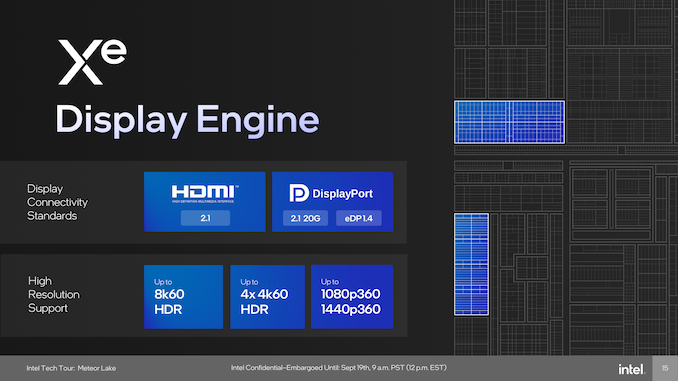Intel Unveils Meteor Lake Architecture: Intel 4 Heralds the Disaggregated Future of Mobile CPUs
by Gavin Bonshor on September 19, 2023 11:35 AM ESTSoC Tile, Part 3: Disaggregating Xe Media and Display Engine From Graphics
As we noted earlier, Intel has completely redesigned its graphics, media, and display engine for Meteor Lake and, as such, separates all three entities from each other. While we'll cover the new graphics tile next, we'll start with everything that's not part of the graphics tile. Opting for a disaggregated architecture allows Intel to not only shuffle things around from an IP perspective but also allows Intel to integrate new IPs such as cores, graphics, and I/O as and when advancements have been made at a silicon level, but the design allows unties Intel from being limited to a specific manufacturing process.
Starting things off, we have the Xe Media Engine, which is embedded within the SoC tile. Within the Xe Media Engine are two Multi-Format Codecs (MFX), designed and responsible for all the encoding and decoding tasks. Intel's Meteor Lake with Xe supports the latest codecs ranging from AV1 (decode and encode), HEVC, AVC, and VP9, with up to 8K60 HDR decode supported. For encoding, there's support for up to 8K resolutions with 10-bit color and HDR. Aiming to improve power efficiency on-chip with encode/decode workloads, having a dedicated Media Engine separate from the graphics allows Intel to find granular power savings as things are directed to the Xe Media Engine, which means the graphics tile doesn't need to be powered up to accomplish encode or decode tasks.
The Xe Media Engine provides various functionalities across a large spectrum of different video codecs. This ranges from JPEG/MPEG and AVC to the more advanced VP9, HEVC, and AV1 codecs. Designed to give Meteor Lake a solid level of computational efficiency for video processing, the Xe Media Engine balances the gaps between high-performance output and power efficiency, rendering it particularly well-suited for various applications, from real-time video streaming to high-fidelity playback. There's also support for diverse color formats and bit depths, including but not limited to 4:2:0 at 10-bit and 12-bit, which means it's versatile for video editing and video encoding and should satisfy content creator's needs.
Xe Display Engine: Also Within the SoC
Much like the Xe Media Engine, the Xe Display Engine is also found within the SoC tile on Meteor Lake. Decoupling this directly from the graphics tile and embedded into the SoC allows it to communicate directly with the Xe Media Engine, saving power and improving overall battery life. The engine supports up to four display pipes, two of which have been designed and optimized for low power consumption, further boosting overall efficiency for Meteor Lake.
Looking at compatibility, the Xe Display Engine looks to use the latest connections and ports, including native support for HDMI 2.1, DisplayPort 2.1, Embedded DisplayPort (eDP) 1.4. and even DSC 1.2a. Via these blocks, Meteor Lake can support displays up to 8K60 HDR, or up to 4 x 4K60 HDR displays, and this is on top of 1080p360 and 1440p360 too. This gives Meteor Lake substantial display and multimedia device support, including current and up-and-coming panels.













107 Comments
View All Comments
Orfosaurio - Saturday, September 23, 2023 - link
Please, answer why. I have detected at least some "bias", but why you said that he is a liar?KPOM - Tuesday, September 19, 2023 - link
It does seem that the N3B process isn’t yielding great efficiency improvements. Any chance Apple will be paying a visit to Intel Foundries in the near future? A19 or A20 on Intel 20A?tipoo - Tuesday, September 19, 2023 - link
I'd say there's a real chance as they expect a density crossover in 2025lemurbutton - Tuesday, September 19, 2023 - link
My M1 draws 0.2w - 5w during Geekbench ST. A17 Pro is going to draw considerably less.dontlistentome - Wednesday, September 20, 2023 - link
Good to see the RDF is still alive and strong. Guess we are getting closer to Halloween.tipoo - Wednesday, September 20, 2023 - link
That's weird because the lower power A17 draws up to 14W on app launch, and those numbers are not remotely true for M1. It's impressive compared to high power x86 CPUs, but those numbers just aren't right.lemurbutton - Thursday, September 21, 2023 - link
It's true. Anyone with an M1 can prove it. Run GB5 and open powermetrics in the terminal. It's easy to verify.Orfosaurio - Saturday, September 23, 2023 - link
Have multiple sources verified that peak power draw?bji - Tuesday, September 19, 2023 - link
Off-topic. Just go away please.danielzhang - Thursday, September 21, 2023 - link
You need to rethink.This is stupid comparion and hilarious conclusion.First of all, Geekbench cannot fully reflect x86 performance, you should compare R23 with m2 max and 13900H, the full load efficiency is actually similar.
Second, you exaggerate the efficiency gap by comparing a low powered designed mobile phone soc with desktop chip, intel has low power 15W chips like i7 1335u has great single thread performance as well.
At full load, there is efficiency gap but the gap is not big at full load but at light load, apple leads probably 1.5x.